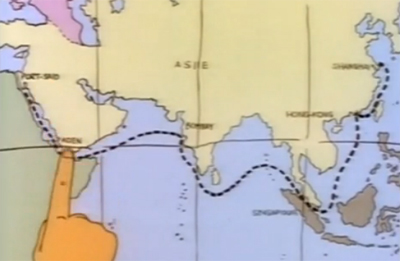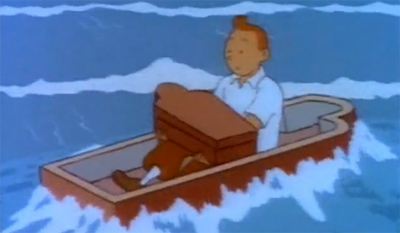To celebrate the release of The Adventures of Tintin: The Secret of the Unicorn in the United States later this month, I’ll be taking a look at some of nineties animated television show. Check back daily!
Note: This is our review of the animated episode, check out our review of the book here.
This is more like it. After a single twenty-three minute episode to cover Tintin in America, Cigars of the Pharaoh gets a bit more space. It’s a very faithful take on the classic story, split over two episodes to retain as much as possible. It’s a good thing, too, as I’d argue that Cigars of the Pharaoh is easily one of the best stories Hergé ever wrote, and certainly the first truly classic entry in the series. So it’s great to see the animated series kicking everything into gear.
I think it’s great that the show was afforded the space required to do the story justice. While a rather brutal editing job undoubtedly did the world of good to the disjointed Tintin in America, I think that Cigars of the Pharaoh really deserves to be told well. Indeed, I was quite disappointed when Spielberg’s The Adventures of Tintin: The Secret of the Unicorn made it clear that the adventure had already happened – I would have loved to have seen the director (or another of his caliber) working on an adaptation of this tale. Still, I suppose Peter Jackson adapting The Seven Crystal Balls will have to be good enough for me. I think I can live with that.
Still, I have to admit I’m a bit disappointed with the DVD and blu ray collections for this series. It’s great to see them released ahead of the movie, because I remember growing up with the series, but I’m disappointed at the way the episodes are structured on the disc. The user is asked to choose a particular story, and selecting the story plays both parts. However, it also plays the opening and closing credits, and the “previously” section from the second episode. I can’t help but feel that this would be better if they played like forty minute animated movies, but I’d settle for some proper chapter stops. This isn’t a problem unique to this television show (unfortunately I see it all the time), but it’s particularly irritating when the menu setup allows the user to play two episodes at a time.
Other than that home media problem, I am actually really impressed with the show. It’s strange, because the animation looks much stronger here than in Tintin in America, despite the fact that this was actually animated before that episode. Perhaps it’s an attempt to mirror Hergé’s style, or perhaps the backgrounds here are more suited to the animators. While all of Hergé’s books are easily recognisable, I think that this was about the point in the series where the author got his technique down, and this adaptation captures it perfectly. While there’s obviously not nearly as much detail as in Hergé’s work, the team do a fantastic job capturing the essence of his style. It really looks impressive. My own personal highlight of this episode is a section where the team animates one of Hergé’s wonderful dream sequences. They are generally surreal and random images, assembled in a way that’s hard to imagine animated, but the team do a fantastic job.
There is another minor frustration with the DVD and blu ray packaging as well, though. The episodes are arranged in the order of Hergé’s stories, rather than the order in which they originally aired. While I can understand the choice, it does lead to the odd confusing moment here or there. For example, Tintin is already familiar with Haddock’s treacherous shipmate Allan, and he and the Thompsons are already friendly – all because The Crab With the Golden Claws was produced and aired first. It’s not a big thing, as it’s easy enough to follow along, but it did take me a moment to find my feet.
Outside of that, it’s very solid. The team do a great job capturing the “feel” of a Tintin adventure – and I’m talking about more than just the distinctive visual style of the artist. Indeed, there are times (like a chase through a village, or a line about digging in the desert) that seem intended to call to mind Raiders of the Lost Ark, which is a movie that perfectly emulated the same sort of pulpy feel that Hergé’s earlier Tintin stories went for.
The episode solidly captures the atmosphere of the piece, with its weird and occult undertones. I’m especially fond of the sequence in the house with the mystical dagger, with almost feels like it could have been lifted from a Hammer Horror film. More than that, I think it’s great the show didn’t mind actually using the word “opium” to describe the traffic that Tintin was breaking up. Given how some shows seem afraid to use words like “kill” and “die”, it’s a nice touch. How many animated television shows teach kids about drug smuggling? Not enough, that’s how many!
There are occasionally cheesy moments. Part of this is down to the fact that some of Hergé’s lines read much better on the page than they do out loud. However, some of it is also down to the writing and delivery. Tintin isn’t a character who can handle James Bond witticisms, and it’s awkward when it misfires. “Eat your cereal and you’ll get a cupcake for lunch!” an orderly declares, as Tintin charges at him. Unable to come up with a wittier response, and feeling the need to say something, Tintin attacks him, observing, “I don’t like cupcakes!” I imagined Bruce Willis offering the same line and… it kinda worked a bit more than it does for Tintin.
Still, it’s fun. I prefer the books, which is probably going to be a recurring theme for everything that’s not Tintin in America, but the cartoon is a great way to introduce younger viewers to the concepts and characters. Plus, you know, it’s kinda fun too.
Filed under: Television | Tagged: Adventures of Tintin, cigars of the pharaoh, Crab With the Golden Claws, Hergé, Pharaoh, The Adventures of Tintin: Secret of the Unicorn, The Adventures of Tintin: The Cigars of the Pharaoh, tintin, tintin in america |
























Leave a comment